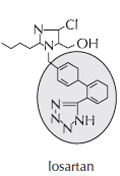The eLitMed.hu medical portal uses computer cookies for convenient operation. Detailed information can be found in the Cookie-policy.
Lege Artis Medicinae - 2006;16(04)
Content
[THE EFFECT OF ANGIOTENSIN CONVERTING ENZYME INHIBITORS ON LEFT VENTRICULAR HYPERTORPHY]
[This study reviews recent clinical data on the development of left ventricular hypertrophy. Several studies have confirmed that left ventricular hypertrophy is associated with an increased mortality and cardiovascular risk. Most antihypertensive drugs provide some regression of left ventricular hypertrophy, but their efficiency varies. Regression can most efficiently be achieved by the use of angiotensin converting enzyme inhibitors and angiotensin receptor blockers.]
[THE ROLE OF STATINS IN THE MANAGEMENT OF PATIENTS WITH ARTERIAL HYPERTENSION]
[Hypertension and hypercholesterolemia are two very important risk factors of cardiovascular diseases. Statins are the most widely used drugs to treat hypercholesterolemia, and they also modify the efficiency of antihypertensive treatment in patients with hypertension. With the use of statins, a significant reduction in blood pressure has been described both in patients previously untreated and in patients already being treated with antihypertensive drugs. The blood pressure lowering effect of statins is partially independent of their effects on the lipid profile, and is probably related to their interaction with endothelial function, angiotensin-II receptor and other biologically important systems. The ability of statins to improve blood pressure control should be more widely considered when thinking of the complex prevention of cardiovascular diseases.]
[CARDIOMETABOLIC EFFECTS OF THE ANGIOTENSIN RECEPTOR BLOCKER TELMISARTAN]
[Telmisartan, an angiotensin receptor blocker, is a potent antihypertensive drug. Similarly to other members of the drug family, it has cardio-, vasoand renoprotective properties; in addition, uniquely in the group, it stimulates the peroxisome proliferator activated receptor (PPAR) -γ. This partial agonist activity results in favourable effects mainly in carbohydrate metabolism and, to a lesser extent, in lipid metabolism. Based on this pharmacological profile, telmisartan seems to be especially useful in the treatment of hypertension associated with metabolic syndrome or type 2 diabetes.]
[THE LONG ACTING INSULIN ANALOGUE DETEMIR IN THE DIABETOLOGICAL PRACTICE: EVIDENCE AND POTENTIALS]
[Insulin detemir is a neutral, soluble, long-acting insulin analogue in which the amino acid threonineB30 has been removed and the LysB29 acylated with a 14-carbon fatty acid. The fatty acid modification allows insulin detemir to dihexamerisate and reversibly bind to human albumin upon administration. This brand new principle (self association and albumin binding) ensures slow absorption and a prolonged and consistent metabolic effect without a marked peak for up to 24 hours in patients both with type 1 and type 2 diabetes mellitus. Results of large clinical trials have shown that detemir can be efficiently used as basal insulin, supplemented with human regular insulin or aspart insulin taken before the main meals, in both type 1 and type 2 diabetes. Available data clearly demonstrate that the use of this insulin is associated with decreased variability of the fasting blood glucose values. In some of the studies the risk of (mostly nocturnal) hypoglycaemic episodes also dropped. It is important to note that patients using insulin detemir gained less or no weight compared to the group of patients treated with neutral protamine Hagedorn (NPH) insulin. Evaluation of long-term and wide-spread application of detemir needs further observations. Such trials are being conducted worldwide.]
[METABOLIC “X” SYNDROME: “XYNDROME” - POSITIONS AND OPPOSITIONS]
[The idea of a constellation of abnormalities linked to insulin resistance as a key component was pioneered and summarized by Reaven in 1988 under the name of “X” syndrome. Based on the various elements of the syndrome, several synonyms have been proposed, including “deadly trio”, “deadly quartet”, “central fat syndrome”, “insulin resistance syndrome”. To avoid the confusion of this entity with “cardial X syndrome”, an established syndrome in cardiology, and instead of the rather long “metabolic X syndrome”, I have proposed the term “Xyndrome”. Irrespective of how it is called, this syndrome has come into the focus of clinical research; using the keyword “metabolic syndrome” to search in the index of the National Library of Medicine, 15.661 citations pop up, and in February 2006 only, 168 papers were published in this field. In spite of this, several international scientific organizations have recently claimed that metabolic syndrome has not been unambiguously defined, its diagnostic criteria are contradictory, and finally, the syndrome as an entity has no more value in predicting cardiovascular risk than the sum of its individual components has, therefore, the use of this notion in the clinical practice is not recommended. There are, however, opposing opinions emphasizing the importance of abdominal obesity - today considered to be most essential element -, data from recent research, and the didactic advantage that the use of this notion has improved complex treatment of its various components. It is crucial to understand that “syndrome” is not more - and not less, either - than a clustering of symptoms and findings, and should not be treated as a distinct disease. The emergence of the notion of metabolic syndrome, however, has been a step forward in the medical concept in that metabolic and cardiovascular diseases are now dealt with in a more complex way, which warrants the maintenance of this notion and the increase of our understanding by continuing research in this field.]
[SOME FORMS OF SECONDARY OSTEOPOROSIS: DIAGNOSIS AND TREATMENT]
[Secondary causes of bone loss are not often considered in patients, who are diagnosed as having osteoporosis. There are many causes of secondary osteoporosis, including endocrine diseases, renal disorders, transplantation, glucocorticoid therapy, inflammatory rheumatic diseases etc. This article gives an overview on the most frequent and in the everyday practice important forms of secondary osteoporosis. The first principle is the correct diagnosis and the adequate treatment of the underlying disease. In the prevention and treatment of secondary bone loss similar principles are followed as in the primary forms. Calcium, Vitamin D, personalized, well-aimed physical therapy and continuous physical activity are the basic treatment of secondary osteoporosis. Active form of Vitamin D, which does not require calcium combination, has to be applied in advanced age, in impaired renal function, and in case of ineffective therapy with cholecalciferol. Evidence based data suggest that bisphosphonates (alendronate and risedronate) are the most effective antiresorptive agents in the prevention and treatment of glucocorticoid- induced osteoporosis and in osteoporosis associated with rheumatoid arthritis. To prevent secondary hyperthyreoidism during bisphosphonate treatment, a calcium intake of 1000 1500 mg/d and an 800 IU/d of cholecalciferol are recommended. Ibandronate (150 mg once a month), a new bisphosphonate will be available soon. Parathyroid hormone (teriparatide) is an anabolic agent, that enhances bone formation. Its recent introduction offers new options in the treatment of patients with established osteoporosis.]
[ENDOSCOPIC AND INTRAVENOUS PROTON PUMP INHIBITOR THERAPIES IN THE TREATMENT OF GASTRODUODENAL ULCER BLEEDING]
[Gastroduodenal peptic ulcer disease accounts for nearly 50% of the cases of acute upper gastrointestinal tract bleeding. Despite early endoscopic diagnosis and treatment, bleeding recurs in 15-20% of the cases within 72 hours. Mortality of recurrent bleeding is high (25-30%), therefore, the main goal of the treatment of patients with bleeding peptic ulcer is not only to stop the bleeding but also to prevent recurrence. The most effective way of the endoscopic therapy is the combination of injection (epinephrine) and thermal coagulation, with supplemental clip placement in spurting arterial bleeding. Overlying adherent clot should be removed after epinephrine has been injected into the ulcer base and the exposed vessel lesion should be coagulated. Proton pump inhibitors promote platelet aggregation and inhibit the proteolytic digestion of clots by raising the pH of gastric juice. The nearly neutral pH necessary for clot stability can be achieved by an intravenous bolus injection of the proton pump inhibitor followed by continuous infusion for 72 hours, after which an oral proton pump inhibitor should be used to prevent late recurrence of bleeding. Proton pump inhibitors can thus contribute significantly to the maintenance of primary haemostasis in patients with bleeding peptic ulcer. Beside omeprazole and pantoprazole that have been available as intravenous proton pump inhibitors, intravenous esomeprazole is a promising new product for the treatment of bleeding peptic ulcer since it ensures a faster and more pronounced intragastric pH increase.]
[QUALITY OF LIFE MEASUREMENTS IN BRONCHIAL ASTHMA]
[Bronchial asthma is a chronic disease with symptoms that significantly influence the daily life of patients causing difficulties in almost every area of life. The author reviews his own results and those published by others on the impact of asthma on the quality of life. The patients' quality of life was assessed using the general quality of life questionnaire EuroQol as well as the disease-specific St. George's Respiratory Questionnaire. Asthma was classified by severity according to GINA, an international classification system. The results of the study provide numerical proof of the concept that due to their disease, patients with asthma have lower quality of life indices than the non-asthmatic population. On examining the effect of age, sex and respiratory functions as factors that influence quality of life, the results indicate that the quality of life of women with asthma is lower compared to men, which is a warning that more attention should be paid on the care of women with bronchial asthma. Since there is only a moderate correlation between respiratory functions and quality of life (r=0.37), the extent of respiratory tract obstruction assessed by objective measurements is not indicative of how the patient is doing. Despite of having normal values, some patients are commonly anxious, are subjects to many real or pseudo-attacks, which in turn leads to greater drug consumption, and judge their state more severe in the symptom diary than actually it is. The findings indicate that beside considering clinical state, symptoms and laboratory results, asthma care should place greater emphasis on the patients’ self-judged quality of life and their own view on their disease.]
[BURNOUT PHENOMENON IN THE MEDICAL PROFESSION]
[Burnout, a physical, emotional and spiritual exhaustion, is caused by chronic emotional stress, and is considered to be the end-state of a multistep process. It is most frequently observed among professionals who work with people and are faced with people's negative emotions every day. Apart from emotional stress, certain personality traits as well as high workload have also been linked to the development of burnout. Burnout symptoms include physical exhaustion (depleted energy, tiredness, illnesses), emotional exhaustion (hopelessness, depression, suicide), and spiritual exhaustion (pessimism, negative attitudes, dehumanization of patients). Approximately 20% of all medical practitioners in several European countries, as well as in the United States, have been demonstrated to show burnout symptoms. Its prevalence appears to be similar across countries, but shows differences according to medical specialty. Doctors mostly seeing patients with easily curable diseases or with good prognosis have a lower risk of burnout, whereas those seeing chronic or dying patients on a daily basis are at a much higher risk. The prevention is possible in a number of ways, such as ensuring proper work environment, providing personality development and soft skills trainings, and participation in clinical case study workshops. The Humania Professional Socialization Workshop was set up with prevention in mind at Semmelweis University in 2002 to formally provide medical students, as part of their vocational training, with skills and techniques that later will help them cope with hard emotional situations and thus reduce the risk of burnout.]
1.
Clinical Neuroscience
Is there any difference in mortality rates of atrial fibrillation detected before or after ischemic stroke?2.
Clinical Neuroscience
Factors influencing the level of stigma in Parkinson’s disease in western Turkey3.
Clinical Neuroscience
Neuropathic pain and mood disorders in earthquake survivors with peripheral nerve injuries4.
Journal of Nursing Theory and Practice
[Correlations of Sarcopenia, Frailty, Falls and Social Isolation – A Literature Review in the Light of Swedish Statistics]5.
Clinical Neuroscience
[Comparison of pain intensity measurements among patients with low-back pain]1.
Clinical Neuroscience Proceedings
[A Magyar Stroke Társaság XVIII. Kongresszusa és a Magyar Neuroszonológiai Társaság XV. Konferenciája. Absztraktfüzet]2.
3.
Journal of Nursing Theory and Practice
[A selection of the entries submitted to the literary contest "Honorable mission: the joys and challenges of our profession" ]4.
Journal of Nursing Theory and Practice
[End of Life and Palliative Care of Newborns in the Nursing Context]5.
Journal of Nursing Theory and Practice
[Aspects of Occupational Health Nursing for Incurable Patients ]






















